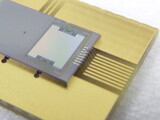The Germany-based research body said they are developing a mini spectrometer that will pave the way for instant quality analysis of whether fruit is ripe or if meat contains too much water.
The experts said the tiny device – 30% smaller than an average sugar cube – employs near infrared technology that can penetrate several centimetres below the outer surface of foodstuffs to measure water, fat, starch and protein content.
The spectrometer can also work with products wrapped in thin packaging film and, say scientists, could take the element of chance out of buying food.
The Fraunhofer said users only need to hold the smartphone near the product in question, activate the corresponding app, choose the food type from the menu – say ‘pear‘ – and straight away the device will make a recommendation.
If it detects the fructose content of the fruit is high it will make a positive recommendation.
Sugar lump-sized spectrometer
The miniature equipment (see below) works by shining a broad-bandwidth light on the item to be tested. Depending on the food’s composition, it will reflect different wavelengths of light in the near infrared range with different intensities. The resulting spectrum tells scientists what amounts of which substances are present in the foodstuff.

While the technology is well-established, the Fraunhofer said the breakthrough is the size if the equipment. With a volume of only 2.1 cc, it is 30 percent smaller than a sugar cube, and thus substantially more compact than its commercially available counterparts, which are around 350 times larger.
Another major advantage is that the devices are inexpensive to make and suitable for mass production.
“We expect spectrometers to develop in the same way that digital cameras did,” says Dr Heinrich Grüger, manager at the institute’s Photonic Microsystems IPMS in Dresden, where the system is being developed. “A camera that cost €500 ten years ago is far less capable than the ones you get virtually for free today in your cell phone.”
Manufacturing technique
The centre has developed a breakthrough process for producing the devices which makes them far cheaper to produce than before.
Spectrometers are usually manufactured by assembling individual components – including mirrors, optical gaps, grating and detector – with each having to be put in place individually and properly aligned.
The IMPS researchers instead manufacture the individual gratings and optical gaps directly on silicon wafers – which are large enough to hold the components of several hundred spectrometers.
This means that hundreds of near infrared systems can be produced simultaneously, said the scientists.
The wafers containing the integrated components are stacked on top of the ones bearing the optical components – producing what are called Micro Electro Mechanical Systems (MEMS) - and then aligned and bound and isolated to form individual spectrometers.
“This means the researchers do not need to position each component, but only the respective composite substrates,” said the Fraunhofer.
A further plus is that the devices produced are more robust than their handmade counterparts.
Time to market
The team said the device could be ready for market launch in three to five years and they are also working on creating a corresponding infrastructure.
“We are developing intelligent algorithms that analyse the recorded spectrums immediately, compare them with the requirements and then advise the consumer whether or not to buy the item,” said Dr Gruger. “This advice is based solely on quality features such as ripeness and water content. The system cannot carry out a microbiological or toxicological analysis.”
